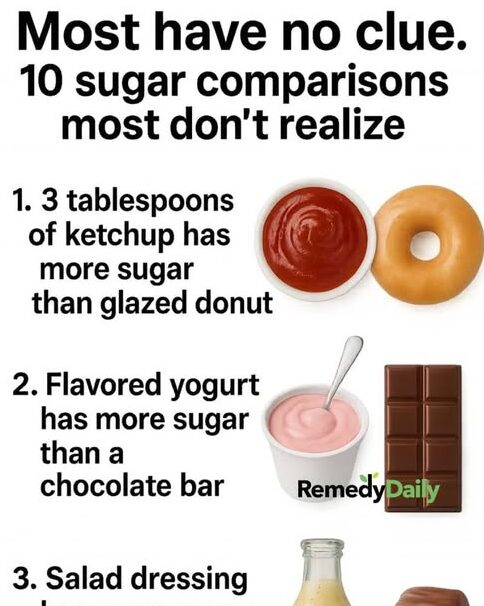Introduction
Sugar is everywhere — not just in desserts or sodas, but in foods we often consider “healthy.” From breakfast cereals to flavored yogurts, hidden sugars sneak into our diets in ways we barely notice. Understanding how much sugar we truly consume can help us make better choices and avoid the health pitfalls of excess sugar intake.
Origin and Cultural Significance
Sugar has played a huge role in human history — once a luxury reserved for the wealthy, it’s now a staple in nearly every processed food. In modern diets, sugar is a source of comfort and pleasure but also a key contributor to rising obesity, diabetes, and heart disease rates. Learning these comparisons isn’t about guilt — it’s about awareness and empowerment.
10 Sugar Comparisons Most Don’t Realize
- Flavored Yogurt (6 oz) – As much sugar as 1½ glazed donuts
- Many “healthy” yogurts pack 18–25g of sugar — more than dessert!
- Can of Soda (12 oz) – About 10 teaspoons of sugar
- That’s roughly 40g of sugar, equivalent to eating 4 Krispy Kreme donuts.
- Bottled Smoothie (16 oz) – More sugar than a candy bar
- Some smoothies contain 50–60g of sugar, especially fruit blends with added syrups.
- Maple Syrup (¼ cup) – Same sugar as 2 Snickers bars
- Even pure maple syrup, while natural, is still dense in sugar.
- Muffin (medium-sized) – Equal to 2 scoops of ice cream
- Breakfast pastries can contain 30–40g of sugar — and that’s before adding coffee creamer!
- Flavored Coffee Drink (Grande Latte or Mocha) – More sugar than a can of cola
- A large flavored latte can have 45–55g of sugar — mostly from syrups and whipped cream.
- Jar of Pasta Sauce (½ cup serving) – Same sugar as 3 cookies
- Surprising? Many tomato sauces contain 10–12g of sugar per serving to balance acidity.
- Breakfast Cereal (1 cup) – As much sugar as 2 chocolate bars
- Even “whole grain” cereals can contain 30g+ sugar per serving when milk is added.
- White Bread (2 slices) – Same sugar as 1 teaspoon of granulated sugar
- Refined bread often hides added sugars to improve flavor and browning.
- Fruit Cocktail in Syrup (1 cup) – Same sugar as a can of soda
- That syrup packs in nearly 35–40g of sugar, making it more dessert than fruit.
Tips for Success
- Read labels carefully: Look for total sugars and added sugars separately.
- Choose unsweetened versions: Plain yogurt, natural nut butter, and no-sugar sauces go a long way.
- Use natural sweeteners wisely: Honey or maple syrup are fine in moderation.
- Limit liquid sugar: Sodas, juices, and flavored drinks are easy to overconsume.
- Balance with fiber and protein: They slow sugar absorption and reduce cravings.
Description
This list reveals how sugar hides in plain sight — turning everyday meals and drinks into stealthy dessert-level indulgences. Once you see the numbers, you’ll never look at “healthy” foods the same way again. Awareness is the first step to change.
Nutritional Information (Perspective Example)
4g of sugar = 1 teaspoon.
- Recommended daily limit (per American Heart Association):
- Men: 9 teaspoons (36g)
- Women: 6 teaspoons (25g)
A single soda, flavored coffee, or sweetened yogurt can exceed that limit in one serving.
Conclusion
Sugar isn’t inherently evil — but hidden sugars can quietly sabotage even the best intentions. Recognizing where they hide allows you to make smarter swaps and enjoy your favorite treats mindfully.
Recommendation
Start small: switch one sugary item each day for a low-sugar version. Try sparkling water instead of soda, plain yogurt with fruit instead of flavored cups, and homemade sauces instead of store-bought.
Embracing Healthful Indulgence
You don’t need to give up sweetness to be healthy. Instead, embrace mindful indulgence — savoring smaller portions, choosing natural sources like fruit, and appreciating the true taste of food without hidden sugar overload. Balance, not restriction, is the key to lasting wellness.
